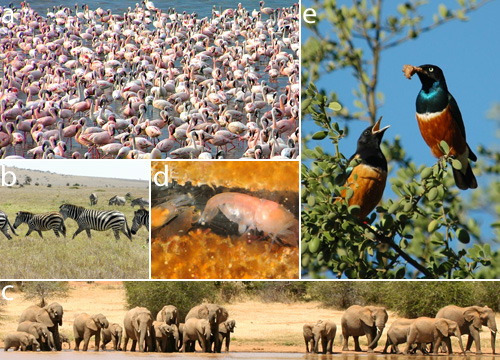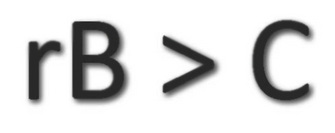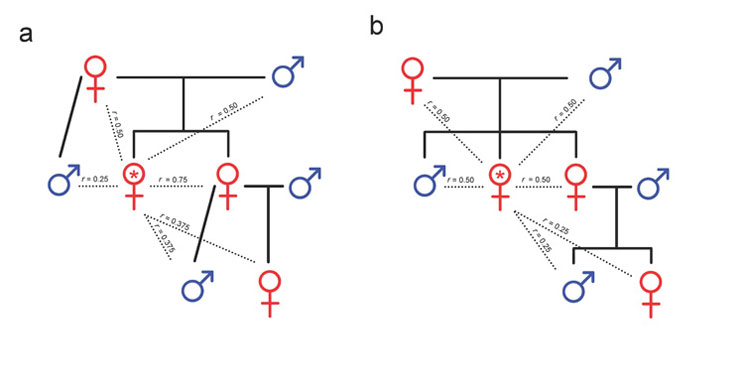Which Of The Following Animals Is The Most Complex
Organisms as diverse as amoebas and elephants frequently alive in groups. Why practice these and many other animals grade circuitous societies?
Organisms are inherently competitive, still cooperation is widespread. Genes cooperate in genomes; cells cooperate in tissues; individuals cooperate in societies. Animal societies, in which collective action emerges from cooperation amongst individuals, represent extreme social complication. Such societies are not but common in insects, mammals, and birds, but exist even in simple species like amoebas (Effigy 1). Animal societies vary in structure from eusocial insect colonies with a single reproductive female supported by hundreds, thousands, or fifty-fifty millions of non-breeding workers, to cooperatively breeding groups of vertebrates with i or more than breeders and a small number of non-breeding helpers. Given the diversity of social taxa, why do some species form complex societies, while other closely related species do non? Within these societies, why practice some individuals effort to reproduce, while others filibuster their own reproductive efforts to help raise the offspring of others? Determining the answers to these and other questions requires because how and why groups form, and how individual behavioral roles are determined within groups.

Figure ane: Group-living is widespread in the animal kingdom.
Although many species form temporary associations, such as (a) flamingo (Phoenicopterus modest) colonies and (b) zebra (Equus quagga) herds, some species such as (c) African elephants (Loxodonta africana), (d) snapping shrimps (Synalpheus brooksi), and (e) superb starlings (Lamprotornis superbus) course more permanent social groups and alive together year-circular.
The Costs and Benefits of Group Living
Group-living typically provides benefits to individual group members. For case, most animals just have one pair of optics to look for food or to watch for predators. Animals living in groups, however, benefit from many more pairs of optics to provide vigilance or help fodder. But living in groups may also confer costs to members. As individuals amass, they go more than conspicuous to predators and contest for food tin increment. Therefore, when deciding to join a grouping, individuals must weigh the cost-benefit ratio of living solitarily versus with others. When the benefits of living together outweigh the costs of living solitary, animals will tend to class groups (Alexander 1974). Other benefits of group-living may include receiving assistance to deal with pathogens (i.e., grooming), easier mating opportunities, better conservation of heat, and reduced energetic costs of movements. Other costs of grouping-living may include increased attack rates by predators, increased parasite burdens, misdirected parental care, and greater reproductive competition.
Although many species grade short-term, unstable groups (e.g., herds of wildebeest, colonies of gulls), some form long-term, stable social groups where interactions among members often announced to be altruistic. For instance, when a footing squirrel sounds an alarm call to warn other group members of a nearby coyote, it draws the coyote'due south attention and increases its own odds of being eaten (Sherman 1977). Similarly, when a meerkat forgoes reproduction and instead feeds the young of another group fellow member, it reduces the number of offspring it will produce during its lifetime (Clutton-Brock et al. 2001). Scientists since Darwin have wondered why animals like these perform cooperative behaviors that may be detrimental to their own evolutionary fitness. One fundamental to understanding such donating behavior came from Robert Trivers, who considered a hypothetical group of animals in which 1 individual is faced with the opportunity to take a small run a risk in gild to provide a big benefit to another (Trivers 1971). Although choosing non to help is typically the best choice for an individual's fettle in the short-term, it could mean that the individual will not receive reciprocal help from others when information technology is needed in the futurity. This provides incentive for altruistic behavior in situations where individuals collaborate repeatedly, which typically occurs when animals alive in stable groups. For example, many primates similar baboons live in big groups and form coalitions where such cooperative interactions are frequent.
Kin Selection and Living in Families
Altruistic behavior can benefit individuals even when information technology is not reciprocated. William Hamilton was amongst the first to realize this when he considered how altruistic behaviors might evolve in living organisms (Hamilton 1963). Based upon observations of social insects, he reasoned that the extent to which an individual is willing to help another should be determined by the caste to which those individuals are related. For case, Hamilton would predict that a person should be more willing to run into a called-for building to rescue their own cousin than they should be to salvage an unrelated stranger. This is because relatives share many genes, and evolutionary fitness is determined by the fraction of an individual's genes that enter the next generation'south gene pool, regardless of whether those genes come up from that detail individual or from identical copies in its relative. If the cousin who is saved goes on to reproduce, then the donating act of saving that relative increases the evolutionary fitness of the rescuer by passing on shared genes.

Figure 2: Hamilton's dominion
Hamilton'southward rule details the conditions under which altruistic beliefs should evolve. It weighs the benefits and costs (in terms of reproductive benefits, or offspring produced) of a donor performing an altruistic behavior towards a recipient. According to Hamilton's rule, the donor receives a direct cost C (in terms of lost direct fettle) for cooperating, whereas the recipient receives an additional benefit B (in terms of increased direct fitness). However, the donor also receives a portion of the benefit B that is discounted by the genetic relatedness r (i.e., caste of shared genes) between the two individuals. This discounted portion of the do good is equivalent to the donor'south indirect fitness proceeds.
Although organisms tin can heighten their straight fitness by reproducing themselves, Hamilton realized that they can also raise their own indirect fitness past helping relatives. He formalized this argument in what has become known as Hamilton'southward Dominion, a general model that calculates the percentage of genes shared between two individuals, and then uses this value to decide the costs and benefits of a cooperative act (Figure 2). Hamilton's insight, termed kin option by John Maynard Smith, was particularly appealing to evolutionary biologists because it appeared to explicate non but why many individuals in complex societies would forgo breeding to help their relatives reproduce, simply also how those societies might evolve (Maynard Smith 1964).
Kin pick theory is peculiarly relevant to social insect societies considering many insects are haplodiploid. In haplodiploid species, an individual's sexual practice is determined not by the presence or absence of a sex chromosome, but instead by the number of copies of the genome in an individual's cells. Diploid fertilized eggs containing ii copies — i from each parent — become females, while unfertilized haploid eggs with only a single copy go males. Kin selection theory suggests that the sexual activity-determined differences in relatedness amidst individuals (Figure iii) provide incentives for young females to stay at home and help enhance their sisters. Yet, initial excitement over this caption equally a main reason for sociality was tempered past observations of non-social haplodiploid species, every bit well as subsequent discovery of eusocial diploid species like termites.

Figure 3: Patterns of relatedness in haplodiploid and diploid species
(A) Haplodiploid and (B) diploid family trees showing the relatedness of an private female (denoted past reddish star) to kin, assuming her mother mates with only 1 male person (i.east., her father). In singly mated haplodiploid species, females are more than closely related to their sisters (r = 0.75) than they are to their brothers (r = 0.25). Haplodiploid females are also more related to their nieces (r = 0.375, Figure 1b) than diploid females are to their nieces (r = 0.25, Figure 1b). However, in many haplodiploid species (including the honey bee) queens are polyandrous and can mate with multiple males, creating broods in which most workers are non full siblings and instead are half-sisters (r between 0.25 and 0.5; the actual value depends on how many males the queen mates with). When queens mate with multiple males, workers are more closely related to the queen's sons (their brothers, r = 0.25) than they are to their one-half-sis's sons (their nephews, r between 0.125 and 0.25). This creates an incentive for workers to police other workers by destroying their eggs.
Eusociality in Insect Societies
The enormous and highly complex societies formed by some insects take been particularly important for studying the causes and consequences of sociality. These groups are called eusocial (i.e., truly social) because they share iii key criteria: 1. cooperative intendance of young; 2. overlapping generations (i.e., parents and offspring cohabitating); and 3. a reproductive division of labor, often culminating in caste evolution (Wilson 1971). Eusociality was first formally described in ants by Wheeler (Wheeler 1928), and has since been shown to be widespread in numerous other insects, most notably in bees, wasps, and termites, equally well as in some other taxa like snapping shrimp and even a rodent.
The coordination that makes a eusocial group successful depends upon the majority of group members forgoing personal reproduction. This allows workers to focus their efforts on specialized tasks, creating extraordinary efficiencies of scale. But why don't workers reproduce? Are they existence coerced into helping by queens, or are they helping voluntarily to gain the indirect fettle benefits of rearing relatives? Inquiry suggests that helping behavior in insects may exist a production of both coercion and voluntary actions. For example, prove of coercion comes from honeybees, where individuals cannot choose their reproductive role and instead develop into either workers or queens based upon the nutrients they receive from others during their larval stage. Even so, there is also evidence from honeybees that workers voluntarily act to maximize their own fitness by rearing relatives. Although worker honeybees are unable to mate and produce diploid offspring, they are capable of laying unfertilized eggs that get males. Surprisingly, this rarely occurs when the queen is alive considering workers law other workers, destroying whatsoever eggs laid. Such behavior maximizes the fettle of the policing worker by ensuring that her free energy is devoted to raising the daughters of the queen (i.east., her sisters) and not her more distantly related nieces (Ratnieks & Visscher 1989).
Cooperative Convenance in Vertebrate Societies
Although few vertebrates are eusocial, many species alive in complex, cooperatively breeding societies in which more than than ii individuals care for immature. Alexander Skutch (Skutch 1935) fabricated the first observations of cooperative breeding in birds, just subsequent biologists have reported the behavior in a variety of other taxa, including many mammals and fish. In addition to breeders, cooperative groups often contain a variable number of non-breeding auxiliaries, or helpers, that aid in raising the offspring of others. Dissimilar the workers of many social insect societies, vertebrate helpers are totipotent and retain the ability to reproduce throughout their lives. In almost, but not all, cooperatively breeding species, helpers tend to be related to the breeders and therefore realize the indirect fitness benefits of raising relatives. In this way, the kin structure of vertebrate societies is like to that of insect societies, even though group sizes are generally an order of magnitude smaller in vertebrates. Cooperative breeding is especially common in birds, including many well-studied species similar Florida scrub jays and white-fronted bee-eaters, and mammals, including many rodents and carnivores.
Whereas kin choice probable underlies the evolution of many cooperatively breeding societies, it lonely cannot explain why some species are social, while other closely related species are non. Biologists take long realized that the environment in which a population lives might influence whether or not its members alive socially. To breed successfully, animals need a variety of resources including territories, nutrient, and fifty-fifty mates. Without such resources, the likelihood of reproducing successfully is low, and so remaining with one'southward family to aid raise relatives may be a amend selection for maximizing fettle than trying to breed unsuccessfully elsewhere (Emlen 1982). In many species of birds, mammals, and fish, younger individuals often filibuster finding their own convenance territories for a few years until a amend opportunity arises, instead remaining at home to gain valuable experience and parenting skills in add-on to the indirect benefits of raising relatives. Similarly, when individuals alive in hostile and unpredictable climates, cooperative convenance may be a conservative strategy to maximize fettle when breeding conditions cannot be accurately predicted from twelvemonth to year (Rubenstein & Lovette 2007). Thus, cooperative breeding can be thought of equally a 'all-time of a bad job' strategy to maximize fettle, either when opportunities for contained breeding are limited or when breeding conditions are uncertain.
Conclusion and Future Directions
Cooperation and sociality are widespread in animals. Seemingly altruistic behaviors, like raising the offspring of others instead of trying to reproduce, can largely be explained by the shared genetic heritage between interacting individuals. Most complex creature societies are actually families in which group members are related and therefore share a high proportion of their genes. The cooperative and often complex collective action that arises from such family unit groups is a product of the interaction of individuals seeking to maximize their own evolutionary fettle.
Genetic structure clearly influences the development of animal sociality. Only do genes themselves influence an individual's altruistic behavior? As new genomic tools become available, one of the challenges in the study of creature societies will be to decide how, and to what extent, individual genes underlie social beliefs. For example, recent studies in wasps suggest that differences in the expression of a relatively small number of genes may exist linked to large social differences in closely related species (Toth et al. 2007). Over the next decade, new inquiry may determine if like genetic mechanisms underlie social behavior in different types of species, including both invertebrates and vertebrates.
References and Recommended Reading
Alexander, R. The development of social behavior. Almanac Review of Environmental and Systematic 5 , 325-383 (1974).
Clutton-Brock, T. H, Brotherton, P. H. M. et al. Cooperation, control, and concession in meerkat groups. Science 291, 478-481 (2001).
Emlen, S. T. The development of helping i: an ecological constraints model. The American Naturalist 119, 29-39 (1982).
Hamilton, West. D. The development of donating behavior. The American Naturalist 97, 354-356 (1963).
Maynard Smith, J. Group option and kin choice. Nature 201, 1145-1147 (1964).
Ratnieks, F. L. W. & Visscher, P. K. Worker policing in the honeybee. Nature. 342, 796-797 (1989).
Rubenstein, D. R. & Lovette, I .J. Temporal ecology variability drives the evolution of cooperative breeding in birds. Current Biology 17, 1414-1419 (2007).
Sherman, P. Nepotism and the evolution of alarm calls. Science 197, 1246-1253 (1977).
Skutch, A. F. Helpers at the nest. Auk 52, 257-273 (1935).
Toth, A. L., Varala, K. et al. Wasp gene expression supports an evolutionary link between maternal behavior and eusociality. Science 318, 441-444 (2007).
Trivers, R. L. The evolution of reciprocal altruism. The Quarterly Review of Biology 46, 35-57 (1971).
Wheeler, W. Grand. The Social Insects: Their Origin and Evolution (Harcourt, Brace, New York, 1928).
Wilson, Eastward. O. The Insect Societies. Cambridge, MA: The Belknap Press of Harvard Academy Printing, 1971.
Source: https://www.nature.com/scitable/knowledge/library/cooperation-conflict-and-the-evolution-of-complex-13236526/
Posted by: jamesexther.blogspot.com

0 Response to "Which Of The Following Animals Is The Most Complex"
Post a Comment